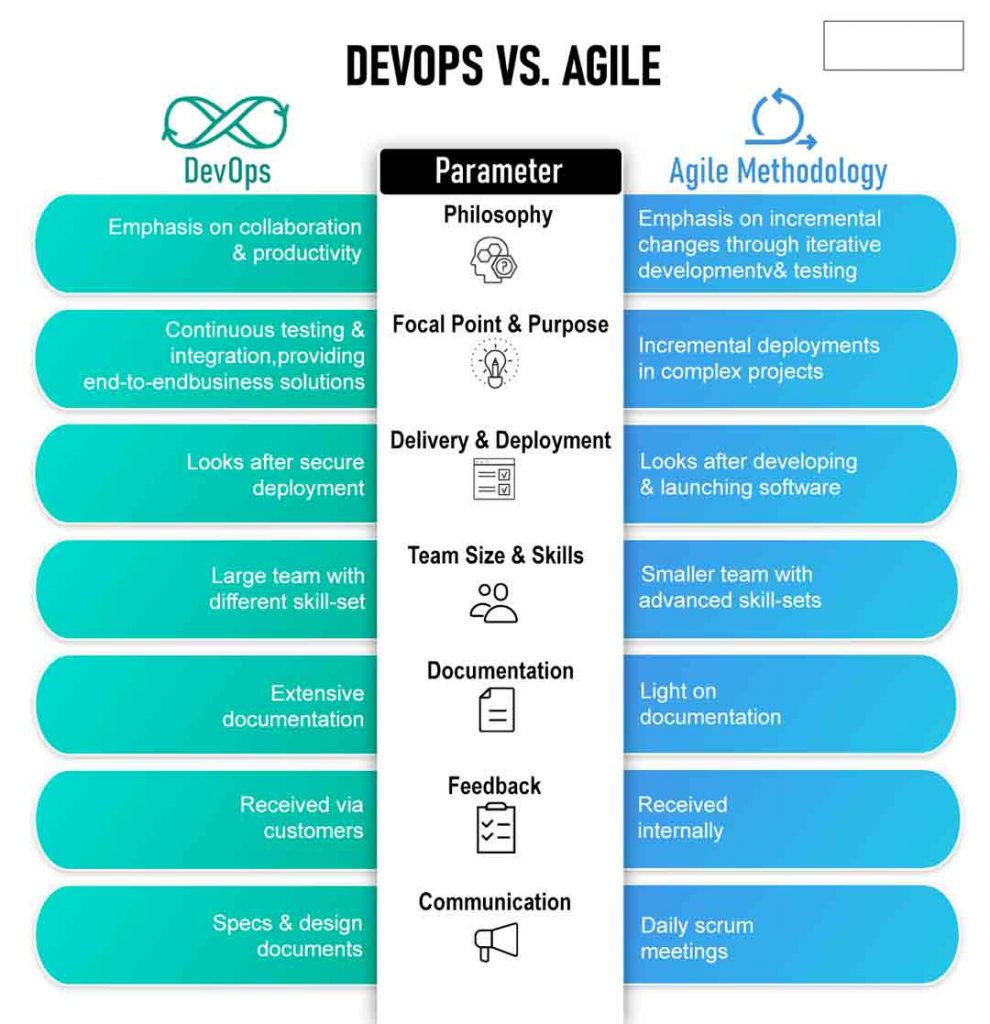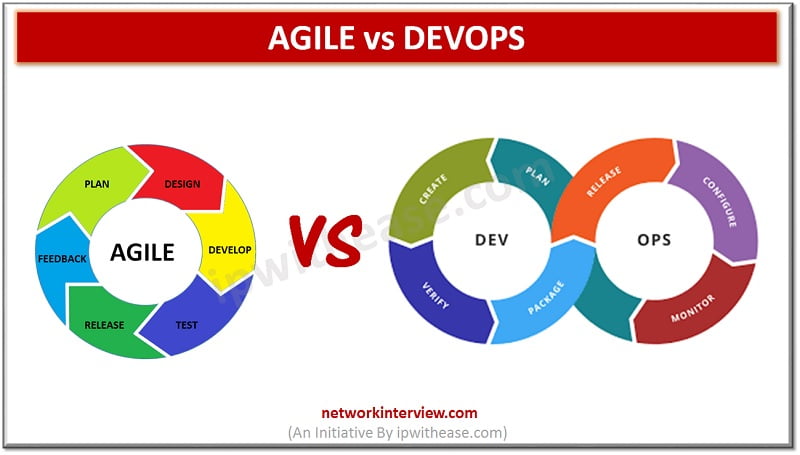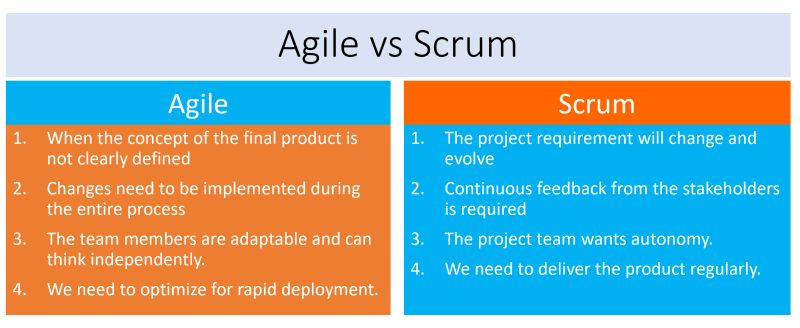Agile, Scrum, and DevOps: An Overview
Agile, Scrum, and DevOps are methodologies that have transformed software development and project management. These approaches emphasize collaboration, continuous improvement, and adaptability, enabling organizations to respond quickly to changing market demands and customer needs. Agile is a project management philosophy that focuses on iterative development, flexible planning, and early delivery. Scrum is a framework that applies Agile principles to facilitate team communication, collaboration, and project execution. DevOps, on the other hand, is a set of practices that combines software development (Dev) and IT operations (Ops) to shorten the system development life cycle and provide continuous delivery with high software quality.
Agile vs. Scrum: Key Differences and Similarities
Agile and Scrum are often used interchangeably, but they represent different concepts in software development and project management. Agile is a project management philosophy that encourages adaptive planning, evolutionary development, early delivery, and continual improvement, focusing on flexible responses to change. Scrum, on the other hand, is a specific implementation of Agile principles, providing a framework for teams to manage and control iterative work at the project level.
Agile and Scrum share several core values, including individuals and interactions, working software, customer collaboration, and responding to change. Both methodologies emphasize collaboration, continuous improvement, and delivering value to the customer. However, Scrum has a more defined structure, with specific roles (such as Scrum Master, Product Owner, and Development Team), ceremonies (Sprint Planning, Daily Scrum, Sprint Review, and Sprint Retrospective), and artifacts (Product Backlog, Sprint Backlog, and Increment). Agile, being a broader philosophy, allows for more flexibility and customization in its implementation.
The Role of DevOps in Agile and Scrum
DevOps is an approach that combines software development (Dev) and IT operations (Ops) to shorten the system development life cycle and provide continuous delivery with high software quality. DevOps complements Agile and Scrum methodologies by emphasizing collaboration, communication, and automation between development and operations teams. By integrating DevOps practices into Agile and Scrum, organizations can achieve faster feedback loops, increased efficiency, and improved customer satisfaction.
DevOps focuses on breaking down silos between development and operations teams, promoting a culture of shared responsibility and continuous improvement. By automating repetitive tasks, such as testing and deployment, DevOps enables teams to focus on higher-value activities, like feature development and customer engagement. Additionally, DevOps practices, like infrastructure as code and monitoring, allow teams to manage and scale their applications more effectively, ensuring smooth and reliable software delivery.
Implementing Agile and Scrum: Real-World Examples
Agile and Scrum methodologies have been successfully implemented across various industries, revolutionizing software development and project management. Here are a few real-world examples:
- Software Development: Many software development companies have adopted Agile and Scrum practices to improve their development processes, reduce time-to-market, and enhance customer satisfaction. For instance, Microsoft has used Scrum to manage the development of its Office products, resulting in faster delivery and higher-quality software.
- IT Services: IT service providers, like IBM and Accenture, have integrated Agile and Scrum into their service delivery models to better manage projects, allocate resources, and meet client expectations. By doing so, these organizations have experienced increased efficiency, better collaboration, and improved customer satisfaction.
- Product Management: Companies like Google and Amazon use Agile and Scrum principles to manage their product development cycles. By implementing these methodologies, these organizations can quickly adapt to changing market conditions, prioritize customer needs, and deliver innovative products that meet and exceed customer expectations.
How to Adopt Agile, Scrum, and DevOps in Your Organization
Adopting Agile, Scrum, and DevOps methodologies in your organization can lead to significant improvements in software development and project management. To ensure a smooth transition, consider the following best practices:
- Start Small: Begin by implementing Agile, Scrum, or DevOps in a single project or team before scaling up to the entire organization. This approach allows you to identify potential challenges, refine your processes, and build momentum for broader adoption.
- Provide Training and Support: Offer comprehensive training and support to help teams understand and adopt Agile, Scrum, and DevOps principles. This may include workshops, mentoring, and access to external resources and experts.
- Establish a Clear Vision and Strategy: Clearly communicate the goals and benefits of adopting Agile, Scrum, and DevOps to all stakeholders. Develop a roadmap that outlines the steps for implementation and aligns with your organization’s overall strategy.
- Foster a Culture of Collaboration and Continuous Improvement: Encourage open communication, knowledge sharing, and collaboration among teams. Emphasize the importance of learning from failures and continuously refining processes to drive long-term success.
- Monitor Progress and Adjust as Needed: Regularly assess the effectiveness of your Agile, Scrum, and DevOps initiatives using relevant metrics and KPIs. Use this data to identify areas for improvement and adjust your approach accordingly.
Measuring Success: Metrics and KPIs for Agile, Scrum, and DevOps
To ensure the success of Agile, Scrum, and DevOps initiatives, it’s essential to measure progress and performance using relevant metrics and KPIs. Here are some key metrics to consider:
- Agile:
- Velocity: The amount of work completed in each sprint, measured in story points or other units.
- Lead Time: The time it takes to go from identifying a requirement to delivering it in a production environment.
- Cycle Time: The time it takes to complete a task or user story, from start to finish, within a sprint.
- Scrum:
- Sprint Goal Achievement: The percentage of sprint goals achieved within the defined timebox.
- Burndown Charts: Graphical representations of work remaining versus time, helping teams track progress and identify potential issues early.
- Sprint Quality: The number of defects or bugs found during and after each sprint, indicating the effectiveness of testing and quality assurance processes.
- DevOps:
- Deployment Frequency: The number of deployments to production environments within a specific timeframe.
- Change Failure Rate: The percentage of changes that result in a failure, requiring a rollback or fix.
- Mean Time to Recovery (MTTR): The average time it takes to recover from a failure, including rollbacks, fixes, and system restarts.
By monitoring these metrics and KPIs, organizations can continuously improve their Agile, Scrum, and DevOps practices, ensuring long-term success and driving value for their customers.
Navigating the Future: Trends and Predictions for Agile, Scrum, and DevOps
As Agile, Scrum, and DevOps continue to evolve and adapt to the ever-changing landscape of software development and project management, several trends and predictions are shaping their future. Here are some key areas to watch:
- Value Stream Management: Organizations are increasingly focusing on value stream management, which involves optimizing the entire flow of work from ideation to production. By integrating Agile, Scrum, and DevOps practices, teams can better manage value streams, eliminate waste, and improve overall efficiency.
- Data-Driven Decision Making: The use of data and analytics in Agile, Scrum, and DevOps initiatives will become more prevalent, enabling teams to make informed decisions, identify trends, and optimize processes. By leveraging data-driven insights, organizations can continuously improve their practices and drive better outcomes.
- Collaboration and Integration: The boundaries between development, operations, and other functions will continue to blur, with increased collaboration and integration across teams. This convergence will lead to more seamless workflows, faster delivery times, and higher-quality software.
- Scaling Agile and DevOps: As Agile and DevOps methodologies mature, organizations will focus on scaling these practices across the enterprise. This scaling will involve refining processes, adopting new tools, and fostering a culture of continuous learning and improvement.
- Adoption of AI and Machine Learning: Artificial intelligence (AI) and machine learning (ML) technologies will play a growing role in Agile, Scrum, and DevOps, automating routine tasks, enhancing predictive analytics, and enabling more efficient decision-making.
By staying abreast of these trends and predictions, organizations can effectively navigate the future of Agile, Scrum, and DevOps, ensuring long-term success and driving value for their customers.
Conclusion: Making Informed Decisions About Agile, Scrum, and DevOps
In today’s fast-paced, ever-changing software development landscape, adopting Agile, Scrum, and DevOps methodologies can significantly improve project outcomes, increase efficiency, and drive value for customers. By understanding the key differences and similarities between these methodologies and their roles in modern software development, organizations can make informed decisions about implementing them in their unique contexts.
When adopting Agile, Scrum, and DevOps, it’s crucial to start small, provide training and support, establish a clear vision and strategy, foster a culture of collaboration and continuous improvement, and monitor progress using relevant metrics and KPIs. By following these best practices, organizations can ensure a smooth transition and maximize the benefits of these methodologies.
As Agile, Scrum, and DevOps continue to evolve and adapt to the changing landscape of software development and project management, staying informed about emerging trends and predictions will be essential for long-term success. By embracing these methodologies and continuously refining their practices, organizations can stay ahead of the competition and deliver high-quality software that meets the needs of their customers.






